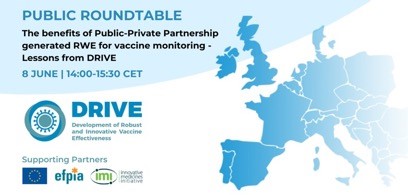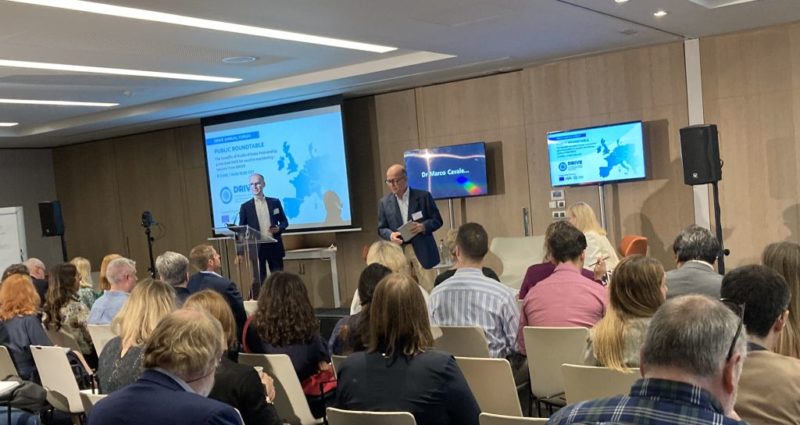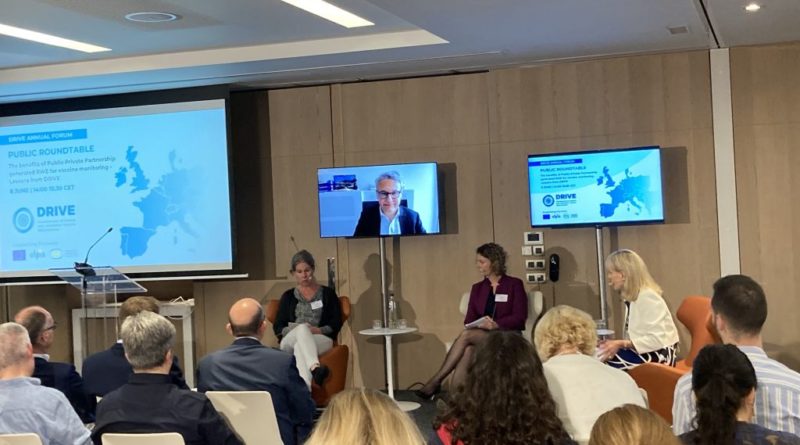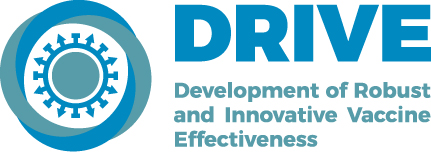On 8 June 2022, as part of its final Annual Forum, DRIVE hosted a public roundtable bringing together key European stakeholders, including public institutions’ representatives, to discuss the initiative’s results after five prolific years. Panellists discussed the benefits of public-private partnerships (PPPs) in generating real-world evidence (RWE) for vaccine monitoring, referencing DRIVE as a scientifically sound initiative able to deliver robust results with a highly transparent governance model, yet hampered by the public’s hostility towards PPPs and particularly the involvement of the industry.

Introducing the discussion, Javier Díez-Domingo (Director of the Vaccine Research Department, FISABIO-Public Health – DRIVE public coordinator), pointed to the difficulties project DRIVE has faced, including the strong reluctance to collaborate in PPPs and the need to convince stakeholders of their benefits. He further pointed to some of the successes of DRIVE, including the setup of a network of thirteen hospitals and public health institutes that have managed to assess influenza vaccine effectiveness of 9 out of the 13 strands circulating in Europe. COVIDRIVE, a PPP whose objective is to assess COVID-19 vaccine effectiveness by brand, has also been set up in less than eight months.
Highlighting how the COVID-19 pandemic has emphasized the need for the public and private sectors to work together to fight public health threats, Cédric Mahé (Head Modelling Epidemiology and Data science, Vaccines, Sanofi – DRIVE EFPIA lead) further elaborated on DRIVE’s successes. He also emphasized that DRIVE platforms can become stepping-stones to evaluate vaccine performance in Europe and serve to evaluate the risk-benefit profiles of vaccines in a timely manner, not only to optimize the use of resources by avoiding duplication of efforts, but also to optimize and build on the expertise of each of the different partners.

Talking about DRIVE, Marco Cavaleri (Head of Biological Health Threats and Vaccines Strategy, European Medicines Agency (EMA)) noted that the project has been an interesting experiment in establishing a PPP model and a network to conduct effectiveness studies. However, since many public health authorities have problems with respect to an open collaboration with industry, strengthening relations with the ECDC is important in the future. Marco Cavaleri also addressed the value of RWE, including for monitoring vaccine effectiveness, disease surveillance and for demonstrating what is the real impact of vaccination. He further outlined the importance, after vaccines are approved and deployed, of collecting additional information as to how they perform in real life, the potential need for adjustment of their risk-benefit profiles and their use for specific populations. This data is in fact helpful not only for regulators in the post-approval cycle, but also for public health authorities, particularly the Technical Advisory Groups deciding how to use and recommend the use of specific vaccines.
Pointing to the fact that the majority of the data emerging in a timely manner with respect to the effectiveness of COVID-19 vaccines come from regions other than Europe, Marco Cavaleri stressed the need to improve the way effectiveness studies are conducted in Europe. To follow up on the need to have an infrastructure that would be able to provide real-time information about the effectiveness of vaccines in Europe, the ECDC and the EMA have decided to create a platform (not a PPP, but a public sector-only one) that would help in streamlining the design and implementation of such studies across a number of different vaccines in use in Europe. This will allow the creation of timely evidence on the effectiveness and safety of vaccines. However, in terms of whether the new public ECDC platform for vaccine monitoring can run in parallel to current DRIVE platforms, he stressed that avoiding duplication is needed, a thought also voiced by Sibilia Quilici (Executive Director, Vaccines Europe). According to Marco Cavaleri, the EMA is currently brainstorming with European institutions to see how this new platform will fit in the overall landscape of efforts conducted in this area, including those by the private sector. The question will then be with regard to the role the industry should play on funding, the contributions of science, and other aspects. First, however, it remains to be seen whether the EMA and the ECDC will be able to build networks and the potential of conducting those studies.
The EMA has not given up on the PPPs model. However, nowadays, considering the current hostility towards the idea, it does not seem possible to implement such a model rapidly, said Marco Cavaleri. There is a need to take stock of the lessons learned from the DRIVE consortium and understand whether this model can be used in specific circumstances or in any other case for which generating additional evidence is needed. It is also necessary to discuss in more detail on how to interact with the industry, especially for authorities and stakeholders within the ecosystem that, unlike regulators, are not used to interacting with manufacturers and see these interactions with hostility.
Hanna Nohynek (Chief Physician, Deputy Head Unit Infectious Disease Control & Vaccines, National Institute for Health and Welfare, THL, Finland) highlighted that being able to employ secondary data and RWE data requires putting more effort to scaling up and making publicly available high-quality vaccine and disease registers. In that sense, she referenced the strengthening of ties between the EMA and the ECDC as a positive development. Addressing DRIVE, Hanna Nohynek referred to it as being a proof of concept on the feasibility of building transparent rules of collaboration, adding that its model is a very strong one, built upon transparent rules of collaboration. Going forward, she added, regulators and public health institutions such as the EMA and the ECDC should look at the progress made over the past 5 years with DRIVE and think about what additional outputs is desired. This may convince the EMA and the ECDC to invest in a model such as DRIVE instead of their new platform, which does not include manufacturers.
Addressing how to best harness the industry expertise when it comes to vaccine monitoring, Sibilia Quilici noted how the vaccine ecosystem is one of complexity, not just in terms of the product itself, but also in terms of delivery. Working in silos is of no use to combat vaccine-preventable diseases. Everything within the vaccine ecosystem is in fact interconnected – surveillance, effectiveness, monitoring. The vaccine industry depends on scientific guidance from the public health institutes to ensure the vaccines that are developed are tailored to what is circulating, but also the vaccine coverage rates to assess outbreak risks and supply needs. Further addressing PPPs, Quilici pointed to one of the values of PPPs that is building trust in the pharmaceutical sector. This allows the demonstration to societies that there is an added value in collaboration and in fighting vaccine hesitancy. On the other hand, silos and discrepancies between the public and private sectors induce vaccine hesitancy, a barrier to the performance of vaccination programs.

Following the roundtable discussion, the floor was opened for further discussion. Pierre Meulien (Executive Director of the Innovative Medicines Initiative (IMI)) noted that PPPs are not for everyone, nor for everything, but they can be the only model to advance certain issues, including vaccine effectiveness. He added that DRIVE is a value-add to the vaccine ecosystem. A multi-disciplinary platform that not only allows for collaboration but also for discussions around issues such as governance, the involvement of public health authorities or the management of conflicts of interest. Harish Nair (Professor of Pediatric Infectious Diseases at the University of Edinburgh, RESCUE and PROMISE Coordinator, and Co-Director of the Center for Global Health) pointed to the current lack of transparency on both the public and private sector, adding that transparency will improve the trust and confidence amongst the different members of the ecosystem, including the public. Patrick Mahy (VAC4EU) picked up on the trust issue pointed out by Prof. Nair, adding that the problem of PPPs hesitancy is not amongst the scientific community but rather the public. Bruno Lina (Scientific Expert for the French Ministry of Health and Temporary Expert for the WHO and ECDC) noted that building diagnostic platforms for other pathogens or respiratory diseases is important to have a broader view of the landscape of circulating pathogens and disease burden, as well as the effect of vaccines on non-target viruses. Having this as open data allows for both the public and private sectors to use these data for the benefit of public health and for anticipating threats. Liz Miller, member of the Independent Scientific Committee that was overseeing the independence and rigor with which the DRIVE consortium produced its results, highlighted how DRIVE ensured that data generated by public health agencies, was utilized to allow the manufacturers to meet their post marketing commitments which had been dictated to them by the EMA.
The Public Roundtable session was closed with the take-home messages for each of the speakers and a thunderous round of applause. In summary, the key messages that emerged from the discussion include:
- DRIVE has been an interesting experiment in establishing a PPP model and a network to conduct effectiveness studies. These studies, which were conducted by public partners independently from vaccines companies, show how independence is not at odds with transparent scientific collaboration with vaccines companies.
- Many public health authorities have problems with respect to an open collaboration with the industry, which makes strengthening relations with the ECDC in the future even more important.
- Taking stock of the lessons learned from the DRIVE consortium will allow for understanding on whether this model can be used in specific circumstances or in any other case for which there is a need to generate additional evidence. It is necessary to discuss in more detail how to interact with the industry, especially for authorities and stakeholders within the ecosystem that, unlike regulators, are not used to interacting with manufacturers. Industry needs access to data as a critical factor that drives the development of the new generation of vaccines. Moreover, having the industry involved allows for the generated results to be immediately fed into drug or vaccine development. Ensuring a good connection between industry, investigators, and regulators is also key to discuss results and move towards regulatory decisions faster.
- One of the values of PPPs is building trust in the pharmaceutical sector so as to demonstrate to societies that there is an added value in collaboration and in fighting vaccine hesitancy. Silos and discrepancies between the public and private sectors induce vaccine hesitancy, creating a barrier to the performance of vaccination programs.
- DRIVE is a value-add to the vaccine ecosystem, a multi-disciplinary platform that not only allows for scientific collaboration but also for discussions around issues such as governance, the involvement of public health authorities or the management of conflicts of interest.
DRIVE partners would like to thank all the speakers and participants for their insights and a fruitful discussion. We would also like to acknowledge the contribution of Sue Saville, who wonderfully moderated the Public Roundtable Session.
To watch the full discussion please click here.
